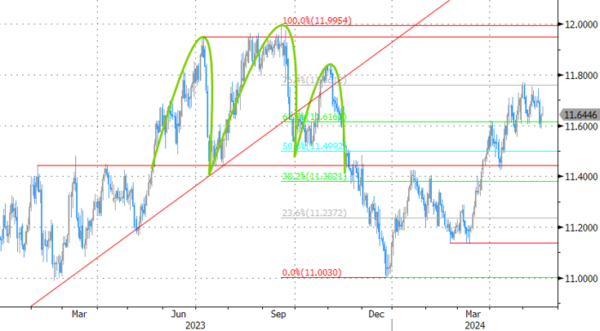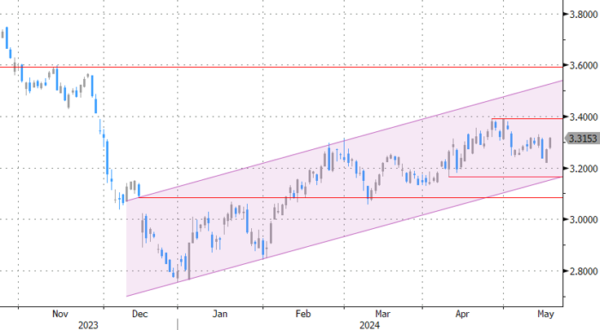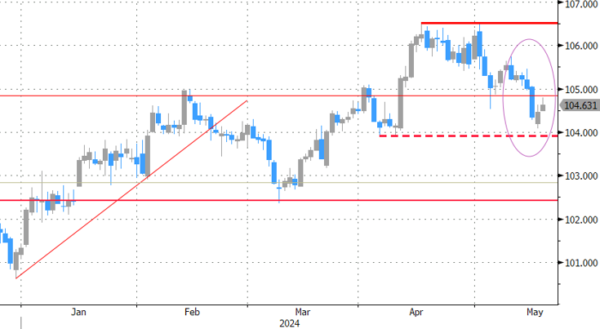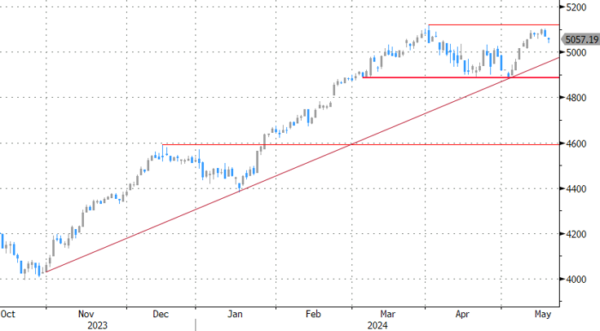Markets
Several ECB policymakers hit the wires today, including Holzmann, de Guindos and heavyweight Schnabel. As a loyal hawk it was no surprise for Holzmann to caution against easing before the central bank is certain of inflation’s return to 2%. De Guindos stuck to the official guidance of a June cut without committing to anything beyond. Schnabel all but ruled out back-to-back cuts, saying that data currently do not warrant it. “The part of inflation that has become entrenched through second-round effects is proving more persistent. Given the high uncertainty about the inflation outlook, we should give ourselves sufficient time to assess how the recovery is proceeding and how monetary policy affects economic growth and inflation.” Schnabel noted how especially domestic inflation is stickier and that further progress is needed. Wage growth plays a significant role here. Next Thursday we’ll finally get the long-awaited outcome of the Q1 wage negotiations, a key indicator watched by the ECB. Apart from that, next week’s agenda also includes the FOMC May meeting minutes & May PMI business confidence. In a sidenote, Schnabel reiterated her belief in a higher neutral rate, especially due to the exceptionally high investment needs arising globally from the green and digital transitions. The comments supported an already ongoing recovery in European yields. Swap rates add between 3 and 4.2 bps. German Bunds underperform Treasuries with yields rising up to 4.7 bps at the front. US yields trade flat (2-yr) to 2.4 bps (30-yr) higher, preserving key technical levels in the process ahead of the weekend (4.70-4.74% for the 2-yr yield and 4.35-4.37% for the 10-yr yield).
Currency markets trade pretty calm with a general bias towards USD strengthening. A more fragile risk environment on equity markets amid all the buoyancy earlier this week helps the dollar recoup some losses. DXY builds on yesterday’s gains to trade around 104.73. EUR/USD inches south towards 1.0845. Sterling is well bid, eking out a fourth daily gain this week. EUR/GBP drops to 0.856 compared to a 0.858 open. The British eco calendar next week holds some interesting data including PMI’s, retail sales and April CPI. Strong negative base effects will push the latter significantly lower and even close towards the 2% target on a y/y basis. Despite core and services gauges still being well above that level, it will probably add to the BoE’s growing conviction that a rate cut soon (June) may be warranted. Money markets currently attach a 60% probability to that scenario.
News & Views
China today announced an in ex extenso plan to address the crisis in its property market. At the core of the plan are measures to support local governments to buy unsold homes in order to convert them into affordable houses for low and middle-income citizens. The package also includes scrapping a minimum interest rate on mortgages and lowering the required downpayments for first-time homebuyers (from 20% to 15%). The central bank announced a CNY 300 bln refunding program providing financing to banks to support buying of homes by state-owned firms. Still there are doubts whether the measures and amounts announced today will suffice to restore the supply-demand balance in a distorted housing market. Illustrating the problems in the sector, data published this morning showed prices of new homes declining by 0.58% M/M and 3.51% Y/Y, accelerating from -2.65% Y/Y in March.
Riksbank Governor Erik Thedéen in a speech today said that ‘Following a period with substantial global price impulses, price growth in Sweden of around 10 per cent and considerable uncertainty over inflation prospects, we are now back in a situation where inflation is close to the target of 2 per cent and where the prospects for continued low inflation are favourable’. This allowed the RB to start easing policy. The RB governor reconfirmed that if the inflation outlook holds, the policy rate could be cut two more times during the second half of the year. Still any policy adjustment needs by characterized by caution. In assessing the inflation outlook the RB also needs to consider international developments which affect the Swedish economy, via several different channels, including the exchange rate. The krone today trades marginally weaker at EUR/SEK 11.64 with the YTD low for the krone still not that far away at EUR/SEK 11.77.
Graphs
EUR/SEK: Riksbank governor Thedeen confirms two more cuts later this year, provided the current outlook holds

European 2-yr swap yield ends the week with gains. ECB’s Schnabel rules out back-to-back cuts and argues for caution

DXY tries to regain some of the sharp losses incurred earlier this week amid signs of bottoming out

EuroStoxx50 struggles for direction after closing at a new 24-yr high earlier this week.









